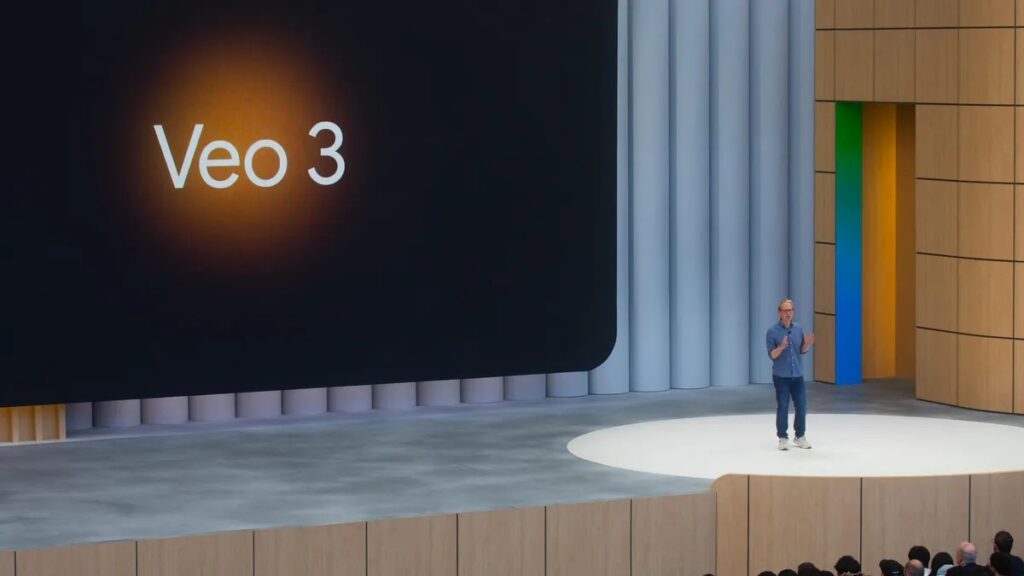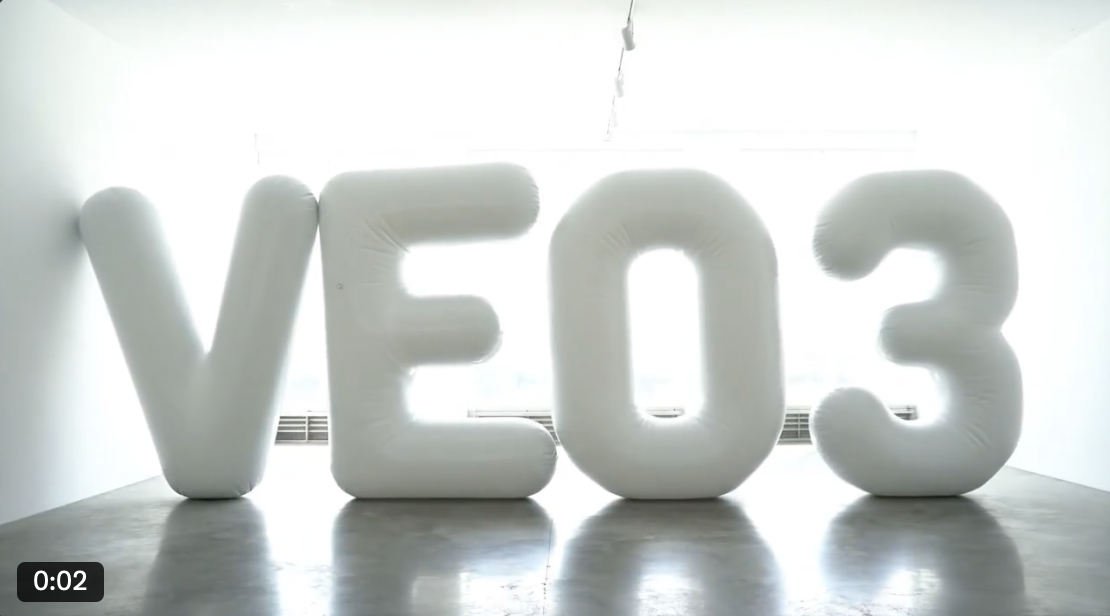Google Veo 3, unveiled at Google I/O 2025, is a groundbreaking AI video generation model developed by Google DeepMind. This state-of-the-art tool is redefining storytelling by transforming text and image prompts into hyper-realistic, high-quality videos with native audio integration.

With advanced features like synchronized dialogue, sound effects, and improved physics, Veo 3 stands out as a game-changer for filmmakers, creators, and businesses. In this article, we’ll explore what Google Veo 3 is, its key features, how it works, and why it’s making waves in the AI and creative industries.
What is Google Veo 3?
Google Veo 3 is an advanced text-to-video and image-to-video AI model designed to empower creators with cinematic-quality content creation. Announced on May 20, 2025, it builds on its predecessor, Veo 2, by offering enhanced video quality, realistic physics, and the ability to generate native audio, including dialogue, sound effects, and ambient noises. Unlike other AI video generators like OpenAI’s Sora, Veo 3’s audio integration makes it uniquely immersive, producing lifelike videos that blur the line between reality and AI-generated content.
Available through Google’s Gemini app and Flow, a dedicated AI filmmaking tool, Veo 3 is accessible to Google AI Ultra subscribers in over 70 countries, with a focus on creative control and narrative-driven video production.
Key Features of Google Veo 3
1. Native Audio Generation
One of Veo 3’s standout features is its ability to generate synchronized audio, including character dialogue, sound effects, and background music. This marks a significant leap from previous models like Veo 2, which lacked integrated sound. For example, a prompt describing an old sailor gesturing at the sea can produce a video with crashing waves and spoken dialogue, creating a fully immersive experience.
2. Enhanced Video Quality and Realism
Veo 3 excels in producing high-definition, 8-second video clips with improved physics, accurate lip-syncing, and lifelike human features. It adheres closely to complex prompts, ensuring precise translations of detailed scenes, such as a paper boat navigating a rain-filled gutter or a futuristic city with reflective chrome buildings. The model minimizes common AI artifacts, making videos nearly indistinguishable from real footage.
3. Advanced Creative Control with Flow
Google’s Flow tool, designed specifically for Veo 3, integrates with Gemini and Imagen 4 to streamline video production. Flow allows users to specify camera movements, edit scene order, and refine visuals and sound. Creators can maintain character consistency across scenes using reference-powered generation, ensuring cohesive storytelling for short films or marketing content.
4. Reference-Powered Generation
Veo 3 supports image-based prompts, enabling users to provide visual references for characters, objects, or styles. This ensures consistent visuals across multiple clips, a critical feature for filmmakers crafting narrative-driven content.
5. Safety and Watermarking
To address misinformation concerns, Google embeds SynthID, an invisible digital watermark, in all Veo 3-generated content. Additionally, a visible watermark is added to videos (except those created by Ultra subscribers in Flow), though it’s subtle and may be hard to spot. Google is developing a SynthID Detector to help users identify AI-generated content, though it’s not yet widely available.
How to Use Google Veo 3
To access Veo 3, users need a Google AI Ultra subscription, priced at $249.99 per month (with a discounted rate of $124.99 for the first three months). It’s available in the Gemini app and Flow for users in the U.S. and over 70 other countries, with enterprise access through Google’s Vertex AI platform.
Here’s how to get started:
- Subscribe to Google AI Ultra: Sign up via the Gemini subscription portal for full access to Veo 3 and Flow.
- Craft a Prompt: Use text or image prompts to describe your scene, including details like camera angles, characters, and audio preferences. For example, “A wise old owl circling a moonlit forest with flapping wings and orchestral music.”
- Use Flow for Editing: Refine your video with Flow’s tools to adjust visuals, sound, or scene order.
- Generate and Share: Create 8-second clips and share them, ensuring compliance with Google’s terms of service.
For those hesitant about the cost, Google AI Pro offers a trial with Veo 2, which lacks audio but is more affordable at $20 per month.
Google Veo 3 vs. OpenAI’s Sora
Compared to OpenAI’s Sora, Veo 3’s native audio generation is a key differentiator. While Sora produces high-quality videos, it lacks integrated sound, requiring separate audio editing. Veo 3 also outperforms in prompt adherence and realistic physics, though some users note Sora’s wider availability. Veo 3’s integration with Flow and Gemini makes it a more comprehensive tool for cinematic storytelling.
Real-World Applications and Examples
Veo 3 is already making an impact across industries:
- Filmmaking: Filmmakers like Darren Aronofsky have partnered with Google to create short films, such as “Primordial Soup,” showcasing Veo 3’s ability to blend AI-generated footage with real performances.
- Marketing: Creators are using Veo 3 for ads, like a fictional mint brand commercial set in a crowded elevator, delivering punchy, memorable content.
- Social Media: Viral clips, such as “Influenders” by The Dor Brothers, demonstrate Veo 3’s ability to create engaging, realistic content for platforms like YouTube and X.
Challenges and Concerns
Despite its advancements, Veo 3 has limitations:
- Cost: The $249.99/month Ultra plan is expensive, with daily generation limits (e.g., five videos in Gemini, 125 in Flow).
- Prompt Accuracy: Spatial prompts, like specific camera angles, may not always be followed precisely, prioritizing cinematic flair.
- Misinformation Risks: Veo 3 can generate deepfakes, raising concerns about misinformation. TIME’s analysis showed it creating misleading clips, like election fraud or riots, though Google blocks certain sensitive prompts.
- Impact on Jobs: The Animation Guild estimates AI tools like Veo 3 could disrupt over 100,000 U.S. film and animation jobs by 2026.
The Future of Google Veo 3
Google Veo 3 is poised to redefine AI-driven filmmaking and content creation. Its integration of audio and video, combined with Flow’s creative tools, makes it a powerful asset for creators. However, its high cost and ethical concerns highlight the need for responsible use. As Google expands access to 71 countries and develops tools like the SynthID Detector, Veo 3’s influence will likely grow, shaping the future of storytelling.
Conclusion
Google Veo 3 is a revolutionary AI video generator that combines stunning visuals with native audio, offering unmatched creative control for filmmakers and marketers. While its subscription cost and potential for misuse raise challenges, its capabilities are undeniable. Whether you’re a professional creator or an enthusiast, Veo 3 opens new doors for storytelling in 2025. To learn more or try it, visit Google’s Gemini subscription page.

